Final report for WRGR21-009
Project Information
The 2018 WSARE project titled “Ecological and economic benefit-cost comparison of grazed and ungrazed prairie land for critical species protection in western Washington” (#SW18-103) identified that conservation rotational grazing practices can be used to establish and maintain native plant and animal communities while supporting agricultural productivity. Through economic analyses and social surveys, the research team also determined what financial or social incentives might be utilized to support conservation actions on working lands. However, to actually build those incentive programs and integrate conservation actions on working lands, a broad education and outreach strategy must be utilized to engage the landowners, producers, funders, regulatory agencies and conservation professionals. We propose constructing a regional grassland grazing association focused on sharing the principles, practices and programs that support sustainable grazing businesses and healthy grasslands. The content will be driven by the needs and interests of the producers and events and resources will be coordinated by an interdisciplinary team including NRCS agricultural professionals, university extension staff, conservation district education specialists, non-profit conservation ecologists, USFWS biologists, and county planners. This team will develop and host online and in-person workshops, webinars and on-site demonstrations on topics of conservation rotational grazing, cost-share and incentive programs and work together to develop innovative marketing approaches for prairie-friendly agricultural products. Utilizing multiple outreach and education venues (synchronous & asynchronous online events, in-person indoor and outdoor events) will allow for the greatest flexibility as we respond to changing COVID-19 guidelines and it will maximize the community reach of these activities.
This project aims to share information across agencies, disciplines and cultures, while also strengthening the livestock producer community in southwest Washington. While agriculture-based committees and organizations exist, none are focused on livestock producers, with the specialized needs, challenges and opportunities that exist within that community. Due to the fact that most grazing lands in southwest Washington are located on remnant prairies, these ranchers have the unique challenge of managing a successful business while also protecting endangered species on their property. By creating a venue for information sharing, easy access to cost-share and funding opportunities, and enhanced community support, we hope to generate both business and conservation gains for producers in this region. Our four objectives for this project include:
- Connect stakeholders by developing an interdisciplinary, multi-agency, rancher-led grassland grazing association with a minimum of ten participating ranching businesses.
- Expand knowledge and skills associated with conservation grazing principles and practices within the agricultural, conservation and regulatory communities, using results from previous WSARE studies, example conservation grazing management plans and a peer-reviewed Conservation Grazing Guide developed in the previous WSARE study.
- Increase utilization and knowledge of cost-share and easement opportunities among private landowners and document landowner interest in conservation grazing programs.
- Improve marketing and economic opportunities for regional producers engaged in conservation programs through the development of a marketable prairie-friendly agriculture product label.
Farmland and prairies in southwest Washington are threatened, having contracted by over 100,000 acres (65% reduction) and 165,000 acres (>90% reduction), respectively over the past 100 years (USDA-NASS 2017; USDA-NASS 1950). Both contribute ecologically, economically, socially, and culturally to the region. Recent listings of threatened and endangered prairie species have increased tensions, but also inspired partnerships across the farming, conservation, and regulatory communities.
Several recent efforts have identified a striking opportunity to build a coalition for conservation on grazed grassland around a motivated ranching community. A 2018-2020 WSARE evaluation of species protection on working lands, the Thurston County Habitat Conservation Plan (HCP) and the Sentinel Landscape group all suggest large-scale funding and key partnerships are within reach to protect habitat and working lands in southwest Washington.
A 2018 WSARE-funded research project (#SW18-103) identified that specific grazing practices can be used to establish and maintain native plant and animal communities while supporting productivity. Through rotational grazing, spring deferment, and native seeding (termed ‘conservation grazing practices’, or CGPs), the native species richness on grazed farms increased with no detrimental impacts on forage (Bramwell et al. 2019). Additionally, federally threatened Mazama pocket gopher (Thomomys mazama) occupancy was nearly equivalent between ranches and prairie preserves. Through economic and survey analyses the team also determined financial and social incentives that resonate with ranchers. To build incentive programs and implement conservation actions, a strategic education and outreach strategy must engage landowners, producers, funders, regulators and conservation professionals.
The Thurston County HCP has established prairie landscape conservation goals and a foundation from which they can integrate working lands and prairie preserves into landscape-wide conservation. While the previous WSARE-funded project identified and quantified habitat value of working lands, additional outreach is needed to raise awareness among ranchers of incentive options, disseminate research findings, identify eligible conservation acreages, train technical service providers and regulators regarding conservation grazing, and develop tools to support adoption. These actions will create the framework to successfully incentivize conservation on working lands in the HCP.
In 2012, the Sentinel Landscape Program, a partnership between the Departments of Defense, Interior and Agriculture, identified prairies of southwest Washington as the first Sentinel Landscape in the country. This designation recognized the need to conserve working lands to protect rare species around Joint Base Lewis McChord. This program has developed tools for ranking conservation easements, a strategic plan to implement landscape-wide conservation, and convened partners. This project will connect this program to the ranching community and specific grazing practices for prairie protection.
Utilizing existing local data and knowledge, partnerships, and regulatory infrastructure, we will support development of a rancher-led association and coordinate a strategic conservation grazing education and outreach plan. This team will host farm tours, demonstrations, webinars and workshops to share conservation grazing principles and practices, information about incentive programs and farmer-prioritized marketing strategies for prairie-friendly products. This will support relationships in the grassland grazing community, protect working lands, enhance habitat for endangered species, and generate economic opportunity for producers (Figure 1).
Cooperators
- - Producer
- - Producer
- - Producer
Education & Outreach Initiatives
Connect stakeholders by developing a a rancher-led grassland grazing association supported by an interdisciplinary, multi-agency education and outreach team
In three years of Western SARE-funded prairie grazing research trials, a good degree of
cohesion and interest among Thurston County ranchers was achieved. Ranchercollaborators
on this proposal want to build on this cohesion by forming a grassland grazing
association to holistically support the ecological, economic and social sustainability of
grassland-based livestock enterprises. The rancher-driven association will provide a
platform for networking, on-farm demonstrations, and workshop education and outreach
deliverables focused on CGPs. To ensure relevance and retain the interest of members,
ranchers will ‘own’ the entity with the administrative, funding, and organizational support
provided by the proposal partners. Conservation grazing topics will be nested within
rancher-identified educational topics to deliberately support the environmental as well as
the social and economic aspects of sustainability. This addresses input from one
of our rancher-collaborators that “if you only talk about butterflies and gophers, you’re
going to lose the ranchers’ interest pretty quickly.” As COVID-19 conditions permit, two inperson
meetings with food, education, socializing, and networking will be held in winter
2021/spring 2022 and winter 2022/spring 2023. These meetings will include presentations
on conservation goals of the grassland grazing association and rancher-selected topics.
Project partners organized the inaugural Grassland Grazing Association meeting on October 26, 2021. This meeting was hosted by one of our producer cooperators (Kevin Jensen) at the Riverbend Farm wedding barn. In addition to project partners from Ecostudies Institute, Thurston Conservation District, WSU-Extension, US Fish and Wildlife Service and NRCS, a hand-picked group of ~15 producers from around the region that represented different genders, ages, size of operation and type of operation (cattle, sheep, goats, etc.) were invited to attend. We focused on this small select group to start for both safety (limiting group size for COVID-safety considerations) and effective communication purposes. A total of twelve producers attended, along with ten agency representatives. Participants gathered in the open-air barn for a meal and open discussion before the formal program. After introductions, we introduced the concept of the Grazing Association and then divided into small groups to discuss the following questions:
- What do you need to be more successful in managing land, managing livestock, marketing and education/training?
- What tools do you need to accomplish these things?
- What do you hope to get out of a Grazing Association?
Producers provided thoughtful and actionable answers to these questions, providing extensive material which we will use to plan and organize webinars, workshops and on-farm demonstrations throughout the next two years (educational actions associated with the grant). The planning team summarized the producer input and provided written notes to all attendees so they could provide any additional thoughts or feedback. In all, there were 52 primary comments reflecting educational topics across six main categories (practical grazing management, funding and conservation, financial management, markets and marketing, business operations, and land access and regulations). There were 24 non-instructional need requests, five consumer education needs/requests, eight technical resource needs and six general needs.
Building off of the inaugural Grazing Association meeting, we developed a planning team, a Facebook page, and a plan for monthly events, including biannual Grazing Association meetings.
Planning Team: The Planning Team consists of representatives from Ecostudies Institute, Thurston Conservation District, Washington State University-Extension, Natural Resources Conservation Services, U.S. Fish and Wildlife Service Partners Program, and 2-3 local producers. This team is responsible for turning the ideas and needs identified at the first meeting into events (webinars, workshops, pasture walks, on-farm demonstrations) with guest lecturers, catering (if needed), farm hosts, and any additional logistics needed. The Planning Team gathered 3 times in 2022 and 3 times in 2023 to organize events and delegate tasks to the group.
Facebook Page: We created a SW Washington Grazing Association Facebook Page through WSU-Extension to advertise events and provide an online location for producers to share information. It has been an extremely helpful communication and outreach tool for the group. https://www.facebook.com/groups/527815978924785
We have also generated a mailing list of producers, technical service providers, conservationists, agency reps and interested landowners that have attended events. We communicate monthly about upcoming events and opportunities.
Educational & Outreach Activities
Participation summary:
SW WA Grazing Association Meetings:
Meeting #1: Inaugural Grazing Association Meeting at Riverbend Ranch (Oct 26, 2021) – Facilitated discussion regarding Mission, Vision, and Values with catered dinner (20 attendees)
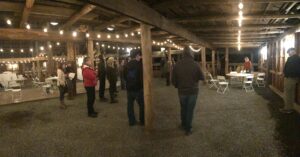
Meeting #2: Developing Goals and Outcomes of Conservation Grazing at Centralia Train Depot (March 31, 2022) – Discussion of meat cooperatives with guest speakers from North Cascades Meat Producers Cooperative and Island Grown Farmer’s Cooperative with coffee and pastries (22 attendees)
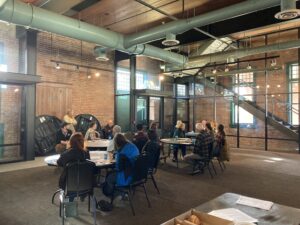
Meeting #3: Prairie Friendly Marketing at the Kodiak Room (November 2, 2022) – Discussion of marketing and labelling strategies with virtual presentation from Dr. Pelayo Alvarez from Audubon Conservation Ranching Program with catered dinner (20 attendees)
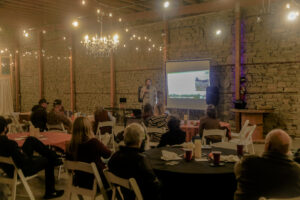
Meeting #4: Carbon Management and Carbon Marketing at the Posse Hall (3/24/23) – Presentation by Jake Schmitz, Carbon Reduction Manager at Neutral Foods. Gathering included presentations, group discussions, and coffee and pastries (32 attendees).

Meeting #5: Looking to the Future: Next Steps for the Grazing Association at Fords Prairie Grange (December 12, 2023) - Large- and small-group discussions about goals, coordination needs and future structure of the Grazing Association, along with a delicious catered dinner that included food produced by ranchers and farmers in attendance (55 attendees).
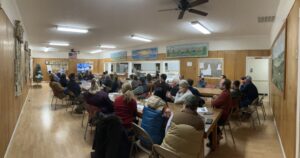
On-Farm Demonstrations
Demo #1: Pasture Walk: Plant Identification at Violet Prairie-Scatter Creek Preserve (April 28, 2022) – Walk and talk, identifying native and non-native species, discussing value of various species for forage, pollinators, birds, soil health, etc. (27 attendees)
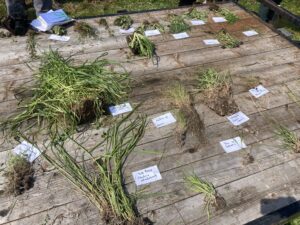
Demo #2: Pasture Walk: Rotational Grazing Treatments and Pasture Design at Flying Cow Creamery/Bone Dry Ridge Farm (July 25, 2022) – Discussion of different types of rotational grazing strategies with different animals (49 attendees)
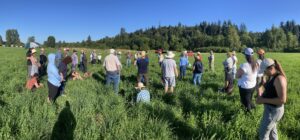
Demo #3: Pasture Walk: Soil Health at Veteran’s Ecological Trades Collective Farm (October 27, 2022) – Discussion of soil sampling techniques, soil nutrient management and relationship between grazing strategies and soil health (16 attendees)

Demo #4: Pasture Walk: Maintaining and Enhancing Prairie Species with Grazing at Mallonee’s Dairy Farm (6/17/23) – Walk through an Organic Valley Dairy Farm operation that supports a federally threatened species (Kincaid’s lupine – Lupinus oreganus) in their grazing fields. Discussion of grazing regime, native plants, and available cost share programs (46 attendees).
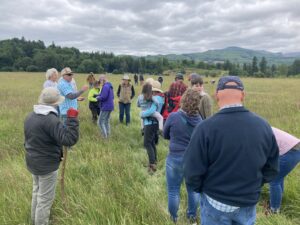
Workshops
Workshop #1: Livestock Fencing at Withywindle Valley Farm (June 18, 2022) – Discussion and demonstration of fencing systems for cattle and sheep, involving active fence-building with various products and tools (25 attendees)
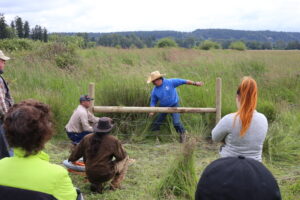
Workshop #2: Cover Crop Trials at Mallonee Farms (August 11, 2022) – Visit and discussion about WSU’s test plots evaluating different varieties of millet, hemp, oats, cowpeas, and radish as cover crops in western WA pastures (47 attendees)
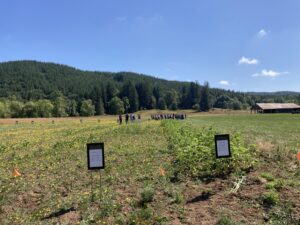
Workshop #3: Nutrition in Pastured Animals at Colvin Ranch (September 24, 2022) – In-field presentation and discussion about the influence of pasture management on animal nutrition, protein levels in pastures throughout the year and choosing the right hay and supplements (15 attendees)
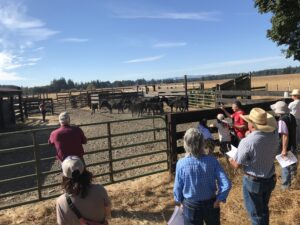
Workshop #4: Parasite Management at Thurston County Fairgrounds (February 27, 2023) - Discussion and demonstration with large-animal veterinarian Mike Paros on the parasite life cycle, good de-worming practices, grazing for parasite management, refugia and resilience in animals, and nutritional needs for animals recovering from heavy parasites loads (31 attendees).
Workshop #5: No-Till Drill Demo at Nelson’s Ranch (May 20, 2023) – Demo-day where producers spoke with equipment operators, learned how to use the equipment, and learned more about no-till practices (34 attendees).

Workshop #6: Conservation Grazing for Oregon Spotted Frog at Mima Creek Preserve (August 26, 2023) – Site tour and discussion of conservation rotational grazing practices being evaluated at a wetland nature preserve that supports a population of the endangered Oregon spotted frog (32 attendees).
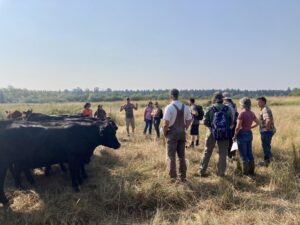
Workshop #7: Conservation and Ecologically Friendly Grazing with New Cowgirl Camp at Broadfields Farm (September 9, 2023) – Attendees learned practical tools for how to assess pasture health and create grazing plans to maximize ecological benefit (21 attendees).
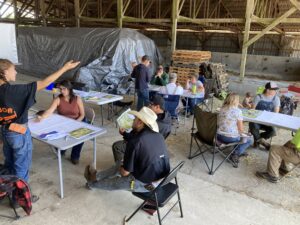
Webinars
Webinar #1: Rancher Stewardship Alliance (March 2, 2022) – Presentation by Martin Townsend, the Conservation Coordinator from Rancher Stewardship Alliance, a rancher-led grassroots organization dedicated to improve the quality of life for rural communities in the northern Great Plains (18 attendees)
Webinar #2: Soil Health and Pasture Renovation (November 17, 2022) – Presentation and discussion of common soil health issues related to grazing management: compaction, forage variety, rest periods, micro & macronutrients, etc. (38 attendees)
Webinar #3: FAMACHA Certification (December 15, 2022) – Hybrid online/in-person presentation and discussion of parasite management in sheep and goats. Participants completed the steps to become certified in FAMACHA (16 attendees)
Presentations
Presentation #1: Bramwell, S.G. June 1, 2022. Oral presentation. Economic impacts of using working lands and prairie preserves for habitat protection, Thurston County, Washington. Association of Natural Resource Extension Professionals biennial conference, Kalamazoo, MI. (20 attendees)
Presentation #2: Hamman, S.T, M.N. Habenicht, S. Bramwell. October 8, 2022. Expanding native prairie conservation value to grazed working lands. Oral presentation, Cascadia Prairie-Oak Partnership Conference. Vancouver, WA. (~100 attendees)
Presentation #3: Bramwell, S.G. and S.T. Hamman. Oct 8, 2022. Developing a strategic approach to support conservation grazing in western WA. Oral presentation, Cascadia Prairie-Oak Partnership Conference. Vancouver, WA. (~100 attendees)
Presentation #4: Bramwell. S.G. Oct 20, 2022. Impact of conservation grazing of western Washington prairie on soil quality and forage species. Poster presentation at South Sound Science Symposium. Little Creek Casino, Shelton, WA (~350 attendees)
Presentation #5: Hamman, S.T. Oct. 20, 2022. Enhancing habitat diversity and functionality with conservation grazing in Coast Salish prairies and wetlands. South Sound Science Symposium. Little Creek Casino, Shelton, WA. (~350 attendees)
Presentation #6: Bramwell, S.G. November 5, 2022. Pasture Management and Rotational Grazing General Principles. Oral presentation to Whidbey Island Organic Farm School, Whidbey Island. (18 attendees)
Presentation #7: Bramwell, S.G. November 21, 2022. Resource provider feature: Supporting Grazing in Western, WA. WSU statewide Cultivating Success Whole Farm Planning course, virtual. (115 attendees)
Presentation #8: Hamman, S.T. February 5, 2023. Biocultural conservation of Pacific Northwest prairies. Oral presentation (virtual) to the Island Conservation Corps, San Juan Island, WA (12 attendees).
Presentation #9: Hamman, S.T. April 21, 2023. Utilizing conservation grazing to improve prairie habitat. Oral presentation to the Southwest Washington Grazing School, Tenino, WA. (35 attendees)
Presentation #10: Chaney, M. June 29, 2023. Forage balance and pasture production. Center for Technical Development Webinar Series.
Presentation #11: Hamman, S.T., S.G. Bramwell, G.L. Slater, S.Waters. August 4, 2023. Quantifying the biodiversity value of working lands to regional prairie conservation. Poster presentation at the 2023 Ecological Society of America Conference, Portland, OR.
Presentation #12: Bramwell, S.G. 2023. Conservation Grazing Impacts on Soil and Forages. Society for Range Management Conference. Poster Presentation.
Presentation #13: Woodham, D., Bramwell, S.G., Smith, S., Mcilquham, M., and Fosnacht, K. 2023. “Soil Health Indicators”. Grazing Association Workshop Series, August 11, Randle, WA.
Educational Tools
Prairie Forage Grass and Forb ID Guide: This guide provides photographs, descriptions and identification tips for 16 grasses and 18 forbs found in western Washington grasslands (see attached).
Prairie Forage Grass and Forb ID Guide_Final
Conservation Grazing Plan Template: This collaboratively developed plan incorporates both production and conservation goals and includes components necessary for NRCS programs so it can crosswalk with other plans required for federal funding programs.
Conservation Grazing Plan Template
Prairie-Friendly Labeling Report: This report summarizes some of the ag marketing labels and networking options currently available for producers that want to highlight certain sustainable practices that they're using in their operations. These were presented to the Grazing Association and discussed to identify if/how these might support producers in this region.
Prairie-Friendly Ag Labeling Report
Conservation Grazing Guide: This guide provides an in-depth review of the theory and practice of conservation grazing and the ecological impacts of this approach, from the soils to the plant communities, with extensive examples from southwest Washington.
We are in the process of publishing our Conservation Grazing Guide and will update once this is peer-reviewed and published.
Learning Outcomes
Project Outcomes
Through this project, we have collaboratively developed a community of producers and conservation practitioners who provide guidance and support to one another, identify community needs, and work together to resolve those needs. The monthly events have generated familiarity and friendships and attracted new participants each month. The facebook page has created a space for sharing information, upcoming local/regional events of interest, and tips for successful ranching operations. The knowledge gained from these events is actively being used in this community and we expect to see increasing conservation gains on successful working lands throughout the region. In total, we had 274 attendees at our events (excluding listed 'Presentations'). Not all events had evaluations (due to logistics or online limitations).
We also surveyed our producer members at the end of the project term about their overall experiences, learning, and recommendations related to the Grazing Association. We had ~50 respondents (approximately 30% response rate). In this survey, 88.6% of respondents said that the Grazing Association has added to the reliable educational opportunities available to them and that the workshops and on-farm demonstrations were the most helpful. Of the respondents, 75% feel their access to a community of livestock producers has increased and 58% feel more supported in raising livestock due to the work of the Grazing Association.
Of individually-evaluated events, attendees gained knowledge in the areas of:
Fencing systems
- permanent fencing (100%),
- temporary fencing (78%),
- fencing practices and technical aspects (78%),
Rotational grazing treatments and forbs
- grazing infrastructure (80%),
- designing pasture management (85%),
- using alternative forbs (93%),
- pasture renovation (80%),
Pasture soil management
- soil sampling methodologies (88%),
- soil test interpretation (100%),
- soil health pasture management (100%)
Pasture plant identification
- Pasture grass and forb identification (100%)
- Native prairie species identification (100%)
- Botanical concepts for plant identification (79%)
Parasite management
- the parasite life cycle (78%)
- pasture management practices to reduce internal parasite loads (71%)
- livestock nutrition to manage/recover from parasites (64%)
- Good de-worming practices (64%)
Paddock design
- Goals for managing animal distribution (78%)
- Tools for managing grazing distribution (72%)
- Logic for arranging paddock design (78%)
- Infrastructure needs for paddock design (61%)
Conservation grazing for native prairie species
- Potential for collaboration with conservation teams (100%)
- Grazing practices to protect rare species (100%)
- How prairie plants support prairie invertebrates (100%)
- Rancher motivations for considering habitat in grazing associations (100%)
“Gained” knowledge noted above includes anyone who recorded from moderate to greatly increased knowledge, which was three response categories.
A majority of attendees indicated they will use the concepts learned, including fencing practices (95%), rotational grazing practices (78%), pasture soil management (57%), and plant identification (98%).
Some quotes from producer responses to our survey:
About the utility of the Grazing Association and associated events:
"I have learned second from other livestock farmers in Thurston county who are attending the events, so I've leaned most from the grazing association farmer to farmer, knowledge spreading farther than just the farmers that attend." - sheep farmer from Southwest Washington State
"Building community and getting to know other farmers has been really valuable. The dinners and talks are very interesting and fun." - new farmer in southwest Washington State
Recommendations for future activities:
"It would be interesting to see if there would be enough participation to host a spanish speaking course in basics of rotational grazing and talking about the resources available like NRCS and TCD that they might not know about. A lambing/kidding course could be fun. Grant writing workshop/ workspace especially around the value-added grant. I want someone to hold my hand and help me learn about applicable grants and then fill them out." - new farmer in Southwest Washington State